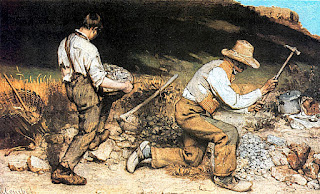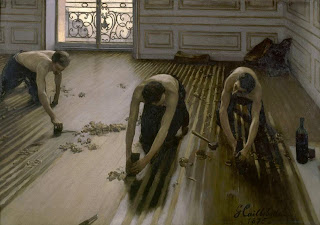Preferences and Perspectives - The Romantic Era
Gustave Courbet,
1849
Destroyed during
World War II
This painting is of two very hard-working men, the younger
one holds a basket and the older one picks at the stones. These men are doing
one of the worst jobs anyone could imagine, creating gravel for roads. This
painting was intended to show the hard labor that poor citizens had to experience.
Stone Breaking was a very low paying job and would require you to work very
long hours in tore up clothes, scratched up knees and weathered cracked hands. Courbet
did not show the figure's faces, they represent the "every man" and
are not meant to be specific individuals. As horrible as this job looks, it was
very important and everybody needed roads to travel, modern life was centered
on roads. More of the details in the painting includes the anonymity of the two
men and their stronger relationship to the land than to their popularity. Even
though they never made history books or barley remembered, they were making
their contribution to the future of society. I think this painting makes a pretty strong
statement, I find realism art to be intriguing because it's more about how
people's lives actually were than what artists could dramatize and make theatrical.
This painting was destroyed in World War II when a transport vehicle moving 154
works was bombed by the allies in 1945.
Les raboteurs de parquet
English: The Floor Scrapers
Gustave Caillebotte, 1875
Location: Musée d'Orsay, Paris
"La Grenouillére"
by Pierre-Auguste Renoir
France, 1869. La Grenouillère is an 1869 oil on canvas
painting by Pierre-Auguste Renoir. La Grenouillère The artist, Pierre-Auguste
Renoir and Claude Monet were actually very good friends and spent a lot of time
together painting the same subject. Look closely and you will see Renoir's usage
of bright brilliant colors that blend together so smoothly and delicately while
his brushstrokes are very short and fast. I think that Renoir's intention was
to create an environment worth experiencing, he made you want to be there with
them. Pierre utilizes shapes with a two-dimensional forms, curved/sketchy lines,
and broken brushstrokes to help create these organic shapes and 2D forms. He
also added, these lines and brushstrokes along with dabs of color help
illustrate an optical look. This painting is now in the National Museum in
Stockholm.
by Henry Fuseli
For this assignment I chose,
The Nightmare by Henry Fuseli. Fuseli first started his studies, he studied in
Italy to learn painting, which is where he had the best experiences in life and
in painting. This painting shows a distressed/asleep woman who appears to be
passed out with a little hairy monkey looking monster on top of her torso. Maybe
this this showing us what type of dream she's supposed to be having, although
this is not certain. It could also be showing a demon that is a resident of the
spiritual world. As it hangs in London's Royal Academy exhibition is has said
to have given many people nightmares of their own. It’s said that the incubus
and horse's head refer to her belief and folklore about nightmares. Fuseli
thought of this image in his mind, not basing it on real live people but more
like a daydream or déjà vu. This specific piece shows both horror and
sexuality, and often brings discomfort to the viewer. Especially how the monkey/monster sits and
stares directly at you being the viewer. To me, it almost looks like the
monkey/monster is taking her soul from her body, that doesn’t look like a
comfortable sleeping position, she looks dead.
This work is painted in a way for texture to appear visible as if it
could be touched and is like silky and soft. The artist of this painting gives
you a lot to think about a lot of facial expressions to read and many of images
to think of and think of what’s going on your own life.
“The Stone Breakers.” Wikipedia, Wikimedia Foundation, 19
Sept. 2021, https://en.wikipedia.org/wiki/The_Stone_Breakers.
“Realism - Important Paintings.” The Art Story, https://www.theartstory.org/movement/realism/artworks/#pnt_3.
https://en.wikipedia.org/wiki/The_Nightmare







These are some great pieces you choose. I really was drawn to realism as it is striking. Having grown up in lower income, I can see the desire people had to be displayed as an everyday person - still worthy of looking at, within art. I believe the second style you were comparing realism to is post impressionism? I mainly think that with the comparison of Pierre to Monet and them working together. Though you do wonderfully describe the elements of art with Pierre, and that piece is just stunning. I would love it in my home! Good job!
ReplyDeleteRealism is immensely interesting. Both of the works which you use show quite muted tones, which further show the pain of the individuals working. I love how the common man could also be considered art, unlike a typical royal or individual with the class as typically seen. It seems that this era focuses more on common individuals rather than formal individuals. Fuseli's work is most definitely captivating!
ReplyDelete